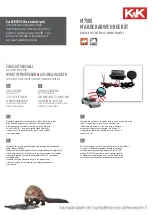
EC-2000-CES MANUAL
54
12.2 SERIAL PORT PARAMETER DATA PACKET INSTRUCTIONS (ALTERNATE METHOD)
It is also possible to write less than a complete data packet. Use the following method.
1.
ASCII characters AA in positions 1 & 2.
2.
Place the data you want to write in the proper location. For example if you wanted to change Speed
No. 4 to 17.00 SPM, you would place ASCII “1700” in positions 31 through 34.
3.
Place ASCII “0” in the 10 spaces following the data (positions 35 through 44)
4.
Place ASCII characters that do not represent numbers or letters in spaces 3 through 30. For
example, you could use “@” or “%”.
5.
Send the data packet to the control. The control will discard the meaningless data and write the
correct data to the correct location. This technique can be used to write any amount of angle or
speed changes. Just place the data you want to write in the proper packet locations. Complete the
packet with (10) “0”s and fill the areas you are not changing with ASCII characters that are not
letters or numbers.
6.
Note the control will not accept “0”s as data.
12.3 SERIAL PORT EXECUTE PARAMETER INSTRUCTION
When ready, the press control will send a two-character packet to the CES controller instructing the
DMR to execute the new parameters. The two ASCII, characters in this packet of bits will be DD. All
characters in the packet will be 8 bit ASCII (the most significant bit being zero) with one start, one stop
and no parity.
In the run mode the new parameters will take effect immediately after the receipt of the “DD”
command, unless the control is in creep mode or is stopping on stop. In that case the command will be
ignored and another “DD” command is required. If the press is stopped, or is operating in the inch or
micro inch mode then the DD command to execute the new parameters is given, the new parameters
will take effect immediately. There are no termination characters for the packets.
12.4 SERIAL PORT FAULT REPORT INSTRUCTION
Fault data is sent by the CES controller upon request of the press control. The two ASCII characters of
the "Request to Send Fault Data" will be BB. The packet length of the request will be two characters.
The DMR will send the fault data in a packet of bits representing ASCII characters. The first two ASCII
characters will be BB. The remaining characters will be four digit numbers, which will represent faults
corresponding to these numbers. Zeros are used to complete the 68-character packet.
Содержание 015-000248-2002
Страница 7: ...EC 2000 CES MANUAL 7 Figure 1 Eddy Current Drive Block Diagram ...
Страница 8: ...EC 2000 CES MANUAL 8 Figure 2 EC 2000 CES Keypad Display ...
Страница 12: ...EC 2000 CES MANUAL 12 ...
Страница 16: ...EC 2000 CES MANUAL 16 Figure 4 Keypad Cutout Template to Scale Inches ...
Страница 17: ...EC 2000 CES MANUAL 17 Figure 5 Keypad Dimensions to Scale ...















































